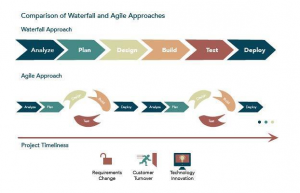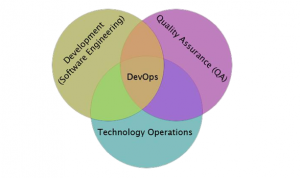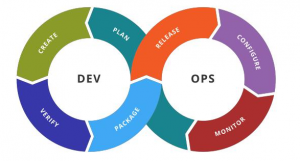
DevOps


Today’s mantra for software delivery is Agility. It is a huge differentiator that gives organizations a competitive edge, and emboldens even fledgling start-ups to challenge giants in the IT industry. Traditional methods of software development have not been able to cope with today’s velocity of delivery and innovation demands, and are screaming for a lighter yet holistic approach. In traditional development models like Waterfall, phases of the development life cycle are followed sequentially: Requirements, Analysis & Design, Development, Integration & Testing, Deployment, and Maintenance, with documentation and sign-off at the end of each phase. This approach is heavy and documentation-intensive and is not quite responsive to requirement or scope changes since it dictates strict adherence to the linear process model. And worse still, the end product of a long-drawn development cycle may not be quite what the customer expected!
Agile development broadly refers to methodologies like Scrum & Kanban that are based on iterative development/testing in short bursts called sprints, continuous feedback, retrospection, course-correction and constant collaboration amongst the teams involved & the customer. This facilitates incremental evolution of the software and adaptability.

The idea behind DevOps is to foster a collaborative work culture within the organization where the Development, QA & ITOps teams work together as one cross-functional unit towards common goals. When the walls of team silos are broken down; teams integrate well with each other; and there is free flow of communication, it percolates down to quicker, quality deliverables with very low failure rates. It is such a basic but powerful idea that makes us wonder why we didn’t do it all along!
DevOps practices help create a standardized and stable operating environment and eliminate the warring dynamics between Dev, QA & Ops teams; each working on their own agenda; refusing to take ownership and blaming each other when issues occur, because they are now one multi-disciplinary unit working together from day 01, with full control and autonomy over the entire software delivery process.

DevOps is a winning combination of healthy work culture, processes and tools/cloud services. A good DevOps implementation ensures incremental evolution of software through processes like Continuous Integration, Continuous Delivery/Continuous Deployment(CI/CD), automated in a process pipeline with an integrated toolchain, so that human-induced wait-time/lag does not hamper agility. Continuous Testing and Continuous Performance Monitoring are also an integral part of this pipeline. Although there will be differences in the DevOps implementation styles and the tools/services used, here’s a quick look at a typical CI/CD process.

Frequent commits and builds of small blocks of code is a DevOps best practice. This prevents the chaos that usually ensues when code from the different feature branches get integrated into the main code branch, firing merge conflicts. Continuous Integration is a workflow strategy that involves compiling the committed code that is on a source repository like GitHub, Azure Repos or Bitbucket, validating it with automated static code analysis, unit and integration tests. The quality of the test suite will determine the quality of the newly integrated code. Typically this involves an Integration server/CI service like Jenkins, Azure DevOps or GoCD that gets triggered on commit(or a pull request(PR) as the implementation may be), that builds the code and runs automated tests.
Continuous Delivery(CD) is an extension of Continuous Integration(CI) where further tests such as UI/UX, Load, UAT, QA are done in varied environments, and finally deployed to a staging environment. This process makes it deploy-ready to production, based on approval.
Continuous Deployment is the same as Continuous Delivery with the exception that the deployable package is automatically promoted into production without the need for human approval. This is routinely done in highly mature DevOps implementations but is obviously too risky for those just starting out on their DevOps journeys. Such organizations could stay with Continuous Delivery until their DevOps environment stabilizes. For those progressing into Continuous Deployment, DevOps offers granular control for things like users to deploy to and the time of deployment.
Infrastructure as Code(IaC) is another important DevOps practice used with Continuous Delivery. As the name suggests, this is the management of infrastructure using code where the desired configuration settings of the environment are specified as code. Every time this code is run, the same environment is generated. This solves issues arising out of inconsistencies in environment configurations and the need for manually maintaining the settings of deployment environments. The pipeline executes this code to configure multiple test targets, enabling application testing in simulated production environments. IaC typically follows application code versioning and is validated just like regular code. It also enables dynamic provisioning of environments on demand.
High delivery velocity and predictable quality are automatic outcomes of a good DevOps implementation since iterative development based on feedback & course-correction, continuous testing & monitoring are core to the methodology. No time is lost in big releases, managing the big release mayhem. Continuous customer feedback looped into the process helps avoid go-live surprises(read shocks) for the customer.
DevOps principles foster responsible autonomy and a spirit of collaboration where the entire cross-functional, cross-trained DevOps team works together and takes end-to-end responsibility from start to finish.
Pipeline Automation injects speed, delivery predictability and enhances productivity by freeing human resources from manual tasks and giving them a sense of satisfaction and purpose as they are able to routinely see their work in customer’s hands.
Everyone wants to hop on the DevOps bandwagon but not all of them have clarity on where and how to start. DevOps is first and foremost a change in work culture and its implementation is primarily an exercise in changing mindsets and behavioural aspects at the workplace.
Importantly, the organization needs to arrive at clear objectives and expected business outcomes. As with most things, it’s always a good idea to start small, stabilize and use that as a pivot to move forward to the next baby step. Piloting it on a low risk application with few users will help everyone ease into the new style of working and give the DevOps movement some momentum. It would also help to initially run the current and DevOps environments in parallel to reduce risk.
Importantly, the initiative needs to be backed by the right processes, automation tools and employee enablement by cross training software developers, QA and IT personnel, enabling them to take charge of the entire process.
Amazon and Netflix are fantastic examples of DevOps done right. Dave Hahn, SRE manager at Netflix says as a company, they don’t think about DevOps and that DevOps is just the wonderful result of a
healthy culture and healthy thinking! Netflix, according to Dave, has millions of customers across the globe, has hundreds of thousands of customer interactions every second, streams tens of billions of hours of entertainment every quarter and manages it all with just 10s of Ops engineers who are also software engineers! That’s the power of DevOps!
For information on our DevOps offerings, please click here.
Please complete the form details and a customer success representative will reach out to you shortly to schedule the demo. Thanks for your interest in ZIF!